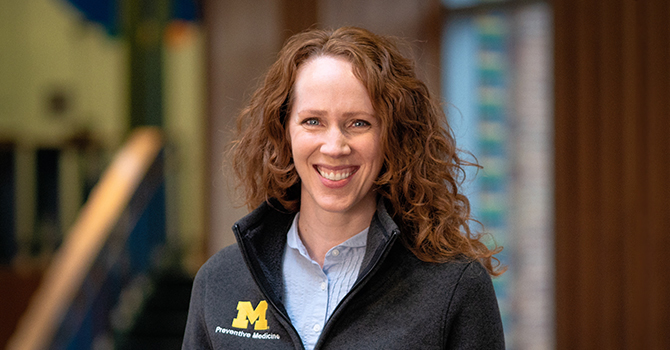Prevention in Action: The Bigger Picture around Individual Infections

Laura Power, MPH ’15
Clinical Assistant Professor of Epidemiology and Internal Medicine; Associate Program Director for the Preventive Medicine Residency
I've always been fascinated by infectious diseases and still remember reading The Hot Zone as an undergrad. In my medical training, I gravitated toward infection prevention and hospital epidemiology.
My role as an infectious disease doctor and as medical director of infection prevention at Henry Ford Health System inspired me to study public health and epidemiology more formally. I wanted to understand the connection between the health system, the community, and governmental public health.
An individual case of a communicable disease is linked to other infections and exposures.
Seeing patients with communicable diseases and working with health departments to notify contacts or manage exposures made me want to understand the bigger picture of public health. An individual case of a communicable disease is linked to other infections and exposures, so it's important to connect with health departments and others in the field to get a picture of the severity of the situation.
I cared for a botulism patient when I was working at Henry Ford Hospital. Immediately, we were in touch with people at the state health department and state laboratory. They helped us confirm the diagnosis, provided the anti-toxin as part of the treatment, and conducted a public health investigation for a disease that could put the whole community at risk.
Public Health in Action
Seeing public health in action like that really drew me in. The teamwork, the different skills needed, and the politics involved was exciting. You want to share information with the public to keep people from getting sick, but you also don't want to ruin a food industry. This particular botulism case, the state investigation concluded—was not a food-borne transmission, so not related to the food supply.
Preventive medicine bridges the space between clinical practice and population health. The more I learned about preventive medicine, the more I was intrigued by it. As the medical director of infection prevention and infectious disease doctor at a large health system, it was definitely a risk to change course mid-career. But I just became increasingly curious about the public health connection to everything I was doing and decided to apply to the Preventive Medicine Residency (PMR) program here at the school.
Preventive medicine bridges the space between clinical practice and population health.
Not only did I complete the residency, but since 2016 I have served as the associate director of the PMR and have a joint appointment in the Epidemiology department at Michigan Public Health and the infectious disease division at the university hospital. At Michigan Public Health, I teach a course about communicable diseases in public health practice, where I try to connect infectious disease with what's happening today in governmental public health. Many of the PMR residents and our master's students in Epidemiology take this class.
Preventive medicine is a unique medical specialty. Preventive medicine physicians are trained in clinical medicine and in public health, allowing them to step back and care for the population they serve. They provide an important link between clinical care and population health because they know how to communicate with other providers, with patients, and with public health professionals. It's actually a lot to master—preventive medicine is the only medical specialty that requires competencies in biostatistics, epidemiology, health behavior, health education, and health management to be board certified.
Seeing beyond Diagnostics
Preventive medicine is about seeing beyond diagnostics and having a vision for working together and solving complex problems, so the field suits professionals who like to make connections and get involved with research, policy, and people outside their own field. When you're engaged in problem solving around a health issue, you need other people that you trust. In the PMR, we build not only technical medical and scientific skills but also the social, leadership, and communication skills needed to connect with people in many sectors of health care and public health.
When you're engaged in problem solving around a health issue, you need other people that you trust.
To join the PMR program, residents have already completed at least one year of clinical training. They spend the first year of the program immersed in graduate-level public health coursework and the second year in practical rotation experiences at local and state health departments, at health systems that address population health, and providing primary and preventive care at local, federally qualified health centers. Elective experiences are also available.
Some of our graduates return to clinical work, others work in public health formally—as medical directors of health departments, as disease detectives with the CDC, as researchers and data analysts, and in various other capacities. We have an alum working in refugee health for the federal government. We also have an alum working in pediatrics, linking her PMR training with clinical practice. This is of tremendous importance as we see the return of so many vaccine-preventable diseases, often in children.
In recruiting for the PMR, we're looking for someone enthusiastic and curious about the bigger picture and someone who can see the benefit of connecting direct patient care with population health. Independent learners do well because the PMR training is quite different than traditional residency where so much of the training is prescribed. We know the transition to the PMR can be challenging, so we look for applicants who push themselves to learn more and don't wait for instructions. We want residents who can connect with people across the entire professional spectrum and who are genuinely curious about what they do and how they do it. We want residents who are open to new ideas and to exploring new problems.
It's a privilege to work with our residents and watch them develop these skills and make these connections. It makes me especially proud to see them discover their own unique path. I think I'm just a natural cheerleader—I like to be proud of people!
